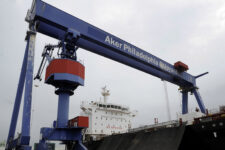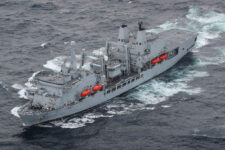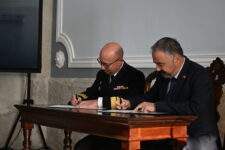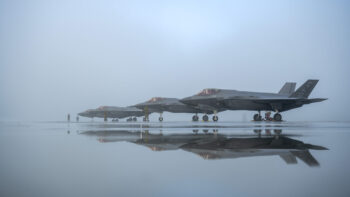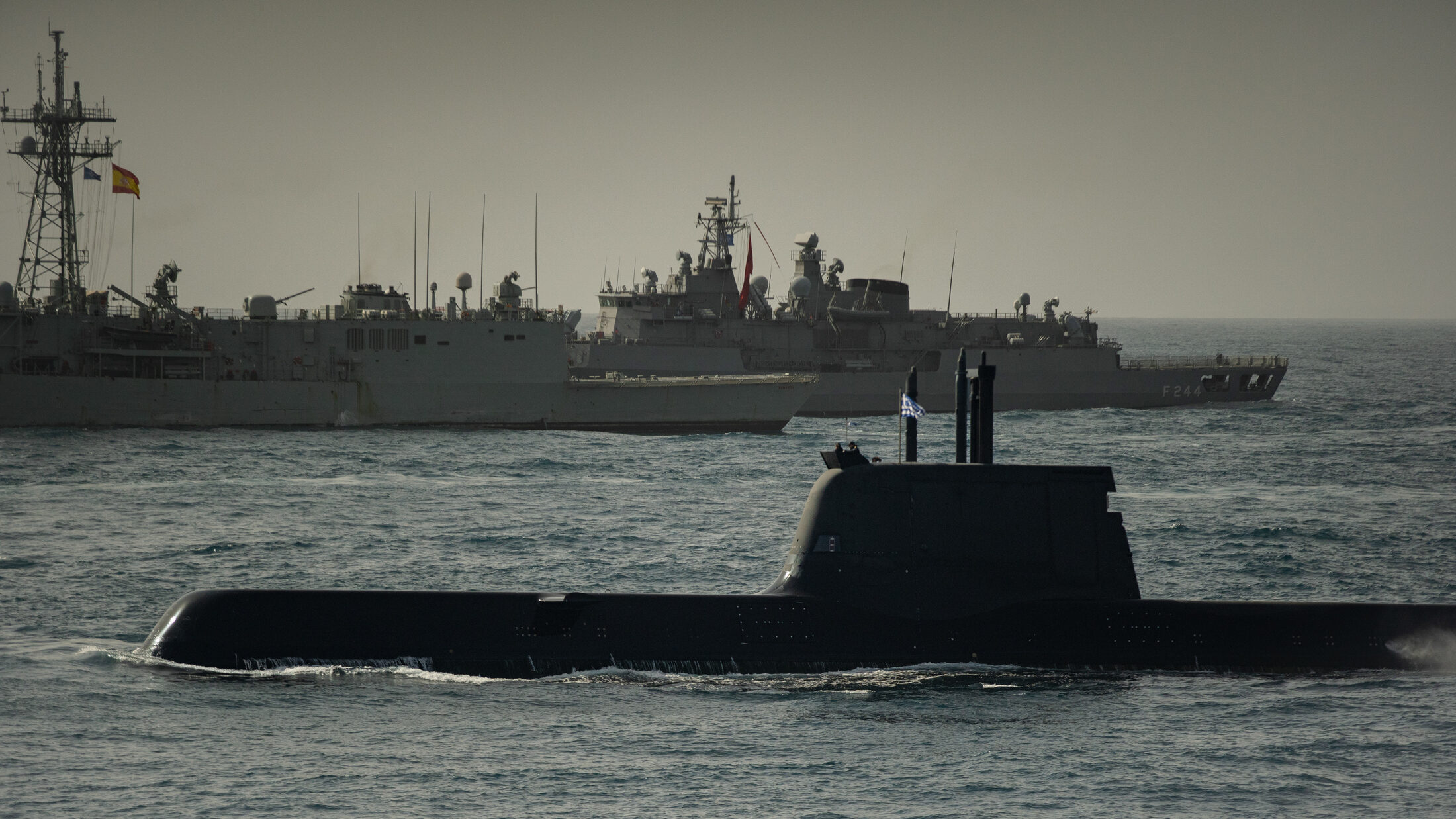
Greek submarine sails in formation with the Spanish frigate ESPS Numancia and the Turkish frigate TCG Barbaros during Exercise Dynamic Manta 23. (NATO)
As heads of state come together at the NATO Summit in Vilnius, Lithuania, this week, all manner of topics are sure to be discussed. In the following op-ed, retired US Adm. James Foggo argues that while there may be many pressing matters, the alliance must make room for a strategic pillar that’s been neglected too long: the maritime domain.
The NATO Summit held in Vilnius, Lithuania, this week presents a tremendous opportunity to talk about the maritime domain’s importance in trans-Atlantic security.
No doubt the agenda will include an update on the war in Ukraine and a call for continued allied solidarity. NATO should be proud of the manner in which the alliance has risen to bolster its defense of Ukraine and its eastern flank. Likewise, the newest NATO member, Finland, will attend its first summit. And there will be a full court press to assuage Turkish President Tayyip Erdoğan to support membership for Sweden — even if Sweden’s accession will have to wait.
Ukrainian membership in the alliance is also on the table after the current conflict subsides. The challenge for the alliance will be to keep the momentum going in this fight towards a favorable conclusion on Ukraine’s terms.
But with all that going on, it will also be important for NATO to remember that the Concept of Deterrence and Defense in the Euro-Atlantic Area, or DDA, is not just a land-centric campaign but a joint combined arms operation that includes the critical maritime domain. NATO must avoid the phenomenon of “sea blindness,” afflicting some nations with maritime borders, who remain complacent about threats from the sea. The three Baltic nations immediately come to mind.
Check out Breaking Defense’s full coverage of the Vilnius Summit by clicking here.
NATO Maritime Strategy hasn’t been updated in more than 12 years. Vilnius provides the perfect venue to jumpstart discussion for a contemporary strategy to meet contemporary threats.
Few should know the urgent need better than NATO Secretary General Jens Stoltenberg, who is a former prime minister of Norway, one of NATO’s biggest maritime nations. The global maritime domain has seen a great deal of change in the last decade-plus, as Stoltenberg learned in 2020 after he commissioned a “Reflection Group” on NATO 2030, co-chaired by Thomas de Maziere, former German Defense Minister, and Wess Mitchell, former assistant secretary of European and Eurasian affairs at the US State Department. Their recommendations with regard to NATO’s maritime strategy are as follows:
NATO… should develop a strategy that takes into account broader deterrence and defense plans. This regional strategy should be built in close coordination with, and with sensitivity to the perspectives of, NATO Allies that are Arctic littoral states. It should include plans for ensuring freedom of navigation in the High North and adjacent bodies of water, including the North Atlantic, as well as provisions for addressing aggressive moves by state actors. In support of these efforts, the 2011 Alliance Maritime Strategy should be updated to reflect new threats to transatlantic communications and NATO’s desire to keep the arctic/High North a region of low tensions.
All new strategies necessarily begin with a conversation about ends, ways and means. We must first determine what constitutes new threats in the maritime domain that NATO must address in order to get to the ends of the strategy—quite simply to ensure a safe and secure maritime environment.
What follows are just a few examples of new threats or concerns that could be addressed in a revised NATO Maritime Strategy. For instance, Europe has seen a significant increase in Russian naval presence in the Eastern Mediterranean, Black Sea, and the High North, particular in the undersea domain. In response, NATO stood up a third Joint Force Command Headquarters in Norfolk, Virginia, commanded by a three-star American officer. Keep in mind that NATO also has a British three-star Maritime commander (MARCOM) headquartered in Northwoods, UK, who commands the Standing NATO Maritime Groups (SNMGs). Notwithstanding the differences in rank, how will the three-star commanders of MARCOM and JFC Norfolk, divide and conquer with the four-star commanders of JFC Naples and JFC Brunssum, in future responses to crises or conflict in the maritime domain?
RELATED: Finnish naval officer talks NATO expectations, Russia’s conduct at sea
It will be important for these three commanders to work together, and seamlessly, across real or perceived maritime boundaries and choke points. I think it would be counterproductive to adopt the American Combatant Commander model of a Unified Command Plan with fixed areas of responsibility and rigid adherence to lines of demarcation. A better model for a NATO maritime strategy would be “one team, one fight,” with all NATO commanders having maritime responsibility, backing each other up in an adaptable and flexible “supported and supporting” command relationship.
Other areas of concern in NATO’s maritime domain include sea-based missile defense capability. So far, the United States has taken the lead on European Missile Defense known as the European Phased Adaptive Approach, intended to protect European capitals from Iranian ballistic missiles. This constitutes the main mission for land-based US missile defense facilities in Romania and Poland and our four Aegis-class destroyers forward deployed in Rota, Spain.
Missile strikes in Ukraine, many originating from the sea, and the sinking of the Russian Black Sea flagship Moskva, have demonstrated the need to bolster NATO’s sea-based missile defense capability. Since 2015, the United States has sponsored the biannual missile defense Exercise Formidable Shield with several live-fire demonstrations of sophisticated and expensive interceptors against a variety of hostile short- or medium-range ballistic missiles or anti-ship cruise missiles. NATO must do more in support allied and partner missile defense. This is an important element for discussion in an updated maritime strategy.
RELATED: Naval warfare poised to play smaller role in year 2 of Ukraine war
The closure of the Black Sea to non-riparian nations under the provisions of the Montreux Treaty have given the Russians an opportunity to act with impunity in this important body of water as well as the Sea of Azov. With a limited NATO presence in the Black Sea, both sides have resorted to mine warfare as a means of limiting access. The increased presence of mines will have long term consequences that NATO will eventually have to address.
NATO must determine how it will eventually return to pre-conflict presence levels in the Black Sea and address the issue of demining. This should not wait until for an eventual cessation of hostilities.
But NATO must also deter and prepare for hostilities beyond Ukraine’s borders. As commander of the sweeping, complex Exercise Trident Juncture in 2018, I learned that in a joint fight of that magnitude, logistics is the sixth domain of warfare. There are more ships at sea under a NATO flag today than since the end of the Cold War. As a result, readiness and sustainment of these vessels will be as much of an issue for NATO as it is for the United States Navy. Addressing readiness, logistics and long-term sustainment of our forces at sea is essential to ensuring a credible deterrent posture and an integral part of a new NATO maritime strategy.
Recent events in the Baltic with the apparent sabotage of the Nordstream II pipeline have focused alliance attention on critical undersea infrastructure (CUI). Whereas 90 percent of global commerce is carried aboard seagoing vessels, 95 percent of our critical data exchange is facilitated by a global network of undersea cables. CUI must be protected in order to achieve our ends of a safe and secure environment, and this must also be addressed in the new maritime strategy.
Finally, much of our attention has been dedicated to the new threat from the Russian Federation. Meanwhile, China is another emerging power and is expanding its presence in the maritime domain. For example, China has declared itself as “a near Arctic nation” and is intent on completing its Belt and Road strategy with a permanent presence in the Arctic Ocean. Though NATO has historically focused on threats to the North Atlantic, as its name demands, China’s actions must be addressed in NATO’s next maritime strategy.
How, for instance, will the alliance react when the first Chinese nuclear submarine pops up at the North Pole or in the warm waters of the Mediterranean? We should not be surprised when this happens, rather we should already have a maritime strategy and common agreement with how to deal with this situation when it does happen.
While the United States turns over the office of the chief of Naval Operations, as well as the commander of the NATO Joint Force Command Norfolk this summer, SHAPE Headquarters in Mons, Belgium, will welcome the first Navy four star deputy supreme allied commander (DSACEUR) in history, creating the perfect opportunity for trans-Atlantic leaders to coalesce around how we will address the significant challenges that we are all facing in the maritime global commons. Let’s start this conversation at the NATO Summit in Vilnius this week.
James G. Foggo is a retired US Navy admiral, former commander of US Naval Forces Europe and Africa and commander NATO Allied Joint Force Command Naples. He is currently the dean of the Center for Maritime Strategy, a nonprofit nonpartisan think-tank.


